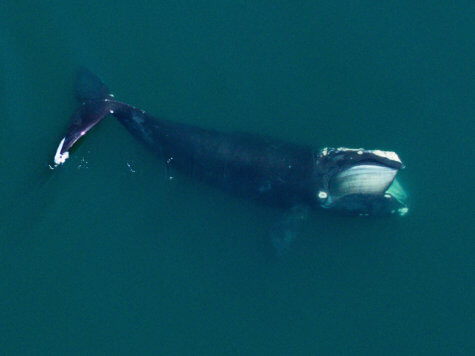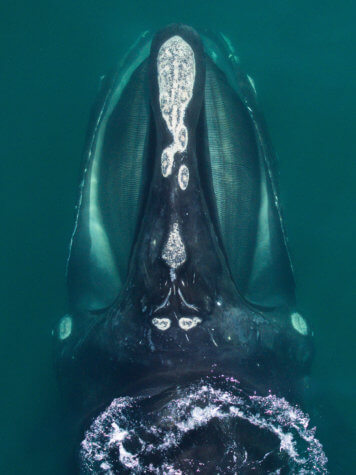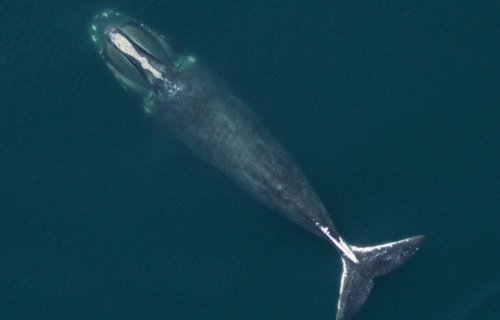LA JOLLA, Calif. — One of the world’s most endangered species of whales has gotten notably smaller in recent years, reveals a new study. North Atlantic right whales have reduced in size by about a meter since the 1980s, say scientists.
Whales are largely protected from being hunted by man, but many populations’ numbers still remain far below what they once were. The new study, published in the journal Current Biology, suggests that, in addition to smaller population sizes, those whales that survive are struggling. As evidence, they found that right whales living in the North Atlantic today are “significantly shorter” than those born 30 to 40 years ago.

“On average, a whale born today is expected to reach a total length about a meter shorter than a whale born in 1980,” says Dr. Joshua Stewart, of the National Oceanic and Atmospheric Administration (NOAA), in a statement.
He notes that represents an average decline in length of about seven percent, adding: “But that’s just the average — there are also some extreme cases where young whales are several meters shorter than expected. Major impacts on life history like this have been documented in heavily exploited commercial species, especially fish, but to our knowledge this is the first time these kinds of impacts are being recorded in a large mammal.”
Dr. Stewart and his colleagues wanted to document the challenges faced by right whales as indicated by changes in their life history characteristics, including size. Using aerial photogrammetry measurements collected from aircraft and remotely operated drones over a 20-year period, they looked for any changes in the body lengths of right whales.
“We were able to build on our previous work that used conventional aircraft in the early 2000s by adopting new drone technology to extend the time series in recent years,” explains Dr. John Durban, formerly with the NOAA, but now a Oregon State University. “In both cases, we were able to measure whales by flying a camera high above them, essentially giving them a health check without them knowing we were there.”
The researchers say that the whales were an “ideal” case study because they’ve been monitored consistently since the 1980s, with individual-level information on age and size and detailed records of attached-gear entanglements. The intensive monitoring made it possible to begin to evaluate the effects that severe and prolonged entanglements may have on the long-term fitness of individuals, as well as the potential effects of other stress factors such as vessel noise, ship strikes, and shifting prey availability.

“Fishing gear entanglements in this population are unfortunately fairly common, and entanglements resulting in attached gear and severe injuries have been generally increasing over the past several decades,” says Stewart. “Previous studies have shown that the increased drag from entangling gear requires right whales to spend a lot of extra energy just to go about their normal activities, and that is energy they might otherwise spend on growth or reproduction. In some cases, entanglements can be lethal, but it turns out that even sub-lethal entanglements can have lasting impacts on right whales.”
Thee data collected shows that serious entanglements in fishing gear are one stressor associated with shorter whales. Dr. Stewart suggests that the stunted growth may lead to reduced reproductive success and a greater likelihood of life-threatening gear entanglements. And he believes the findings in right whales may have implications for other species of large whales around the world.
“The smaller you are, the less energetic reserves you have, and the harder it might be to survive a serious entanglement or sustained food shortage,” he says. “So it’s possible that these life history changes could translate into population viability impacts. But this really makes me wonder about how large whales worldwide are being impacted by entanglements. This is by no means a problem unique to right whales – entanglements are a major threat for whales, marine mammals, and other marine species worldwide.
“Because North Atlantic right whales have this incredibly detailed dataset with known ages, sizes, entanglement histories, and so forth, we could directly examine how these impacts are affecting growth rates,” he continues. “My guess is that many other species are being similarly affected, but we just don’t have the ability to detect it in less well-studied populations.”
Based on their findings, the researchers call for stronger action to reduce the impacts of fishing gear and vessel operations.
“Implementing proven solutions such as reduced vessel speeds, lower breaking strength ropes, and ropeless fishing gear more broadly throughout their range are critical and urgent steps needed to stave off the extinction of this species,” adds study co-author Amy Knowlton, of the New England Aquarium.
Now the researchers plan to explore whether shorter female whales do indeed have fewer offspring.
SWNS writer Stephen Beech contributed to this report.
